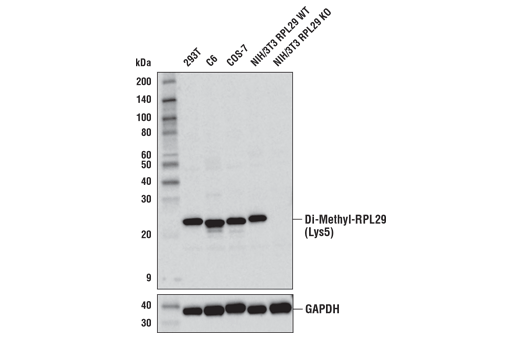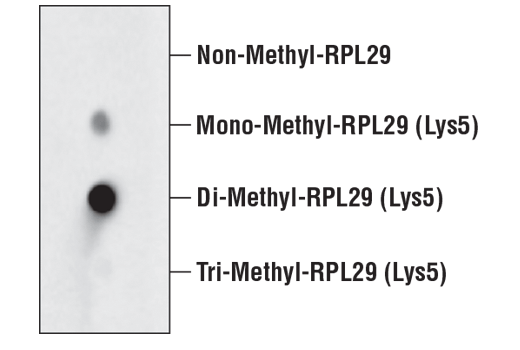WB
H M R Mk
Endogenous
23
Rabbit IgG
#P47914
6159
Product Information
Product Usage Information
| Application | Dilution |
|---|---|
| Western Blotting | 1:1000 |
Storage
Specificity / Sensitivity
Species Reactivity:
Human, Mouse, Rat, Monkey
Source / Purification
Monoclonal antibody is produced by immunizing animals with a synthetic methyl peptide corresponding to residues surrounding Lys5 of human RPL29 protein.
Background
SET7/SET9 is a member of the SET domain-containing family, and can specifically methylate Lys4 on histone H3 (1). Like most other lysine-directed histone methyltransferases, it contains a conserved catalytic SET domain originally identified in the Drosophila Su(var)3-9, Enhancer of zeste and Trithorax proteins. Histone methylation is a major determinant for the formation of active and inactive regions of the genome and is crucial for the proper programming of the genome during development (2,3). Methylation of histone H3 Lys4 enhances transcriptional activation by coordinating the recruitment of BPTF, a component of the NURF chromatin remodeling complex, and WDR5, a component of multiple histone methyltransferase complexes (4,5). In addition, methylation of lysine 4 blocks transcriptional repression by inhibiting the binding of the NURD histone deacetylation complex to the amino-terminal tail of histone H3 and interfering with SUV39H1-mediated methylation of histone H3 Lys9 (1). SET7/SET9 is highly active on free histone H3, but only very weakly methylates H3 within nucleosomes (1). Besides histones, SET7/SET9 also methylates Lys189 of the TAF10, a member of the TFIID transcription factor complex, and Lys372 of the p53 tumor suppressor protein (6,7). Methylation of TAF10 stimulates transcription in a promoter-specific manner by increasing the affinity of TAF10 for RNA polymerase II, which may potentiate pre-initiation complex formation (6). Methylation of p53 at Lys372 increases protein stability and leads to upregulation of target genes such as p21. Thus the loss of SET7/SET9 may represent another mechanism for the inactivation of p53 in human cancers (7).
Ribosomal protein L29 (RPL29) is a ubiquitously expressed protein subunit of the cytoplasmic eukaryotic large 60S ribosomal subunit that functions in the translation of RNA to protein. RPL29 is a non-histone substrate of the SET7/SET9 protein methyltransferase and is exclusively mono- and di-methylated on lysine 5 by SET7/SET9. In addition, RPL29 lysine 5 is demethylated by the LSD1 protein demethylase (8). This antibody provides a specific readout for SET7/SET9 methyltransferase and LSD1 demethylase activities.
- Nishioka, K. et al. (2002) Genes Dev. 16, 479-489.
- Kubicek, S. et al. (2006) Ernst Schering Res. Found. Workshop , 1-27.
- Lin, W. and Dent, S.Y. (2006) Curr. Opin. Genet. Dev. 16, 137-142.
- Wysocka, J. et al. (2006) Nature 442, 86-90.
- Wysocka, J. et al. (2005) Cell 121, 859-872.
- Kouskouti, A. et al. (2004) Mol. Cell 14, 175-182.
- Chuikov, S. et al. (2004) Nature 432, 353-360.
- Hamidi, T. et al. (2018) J Biol Chem , .
Species Reactivity
Species reactivity is determined by testing in at least one approved application (e.g., western blot).
Western Blot Buffer
IMPORTANT: For western blots, incubate membrane with diluted primary antibody in 5% w/v BSA, 1X TBS, 0.1% Tween® 20 at 4°C with gentle shaking, overnight.
Applications Key
WB: Western Blotting
Cross-Reactivity Key
H: human M: mouse R: rat Hm: hamster Mk: monkey Vir: virus Mi: mink C: chicken Dm: D. melanogaster X: Xenopus Z: zebrafish B: bovine Dg: dog Pg: pig Sc: S. cerevisiae Ce: C. elegans Hr: horse GP: Guinea Pig Rab: rabbit All: all species expected
Trademarks and Patents
使用に関する制限
法的な権限を与えられたCSTの担当者が署名した書面によって別途明示的に合意された場合を除き、 CST、その関連会社または代理店が提供する製品には以下の条件が適用されます。お客様が定める条件でここに定められた条件に含まれるものを超えるもの、 または、ここに定められた条件と異なるものは、法的な権限を与えられたCSTの担当者が別途書面にて受諾した場合を除き、拒絶され、 いかなる効力も効果も有しません。
研究専用 (For Research Use Only) またはこれに類似する表示がされた製品は、 いかなる目的についても FDA または外国もしくは国内のその他の規制機関により承認、認可または許可を受けていません。 お客様は製品を診断もしくは治療目的で使用してはならず、また、製品に表示された内容に違反する方法で使用してはなりません。 CST が販売または使用許諾する製品は、エンドユーザーであるお客様に対し、使途を研究および開発のみに限定して提供されるものです。 診断、予防もしくは治療目的で製品を使用することまたは製品を再販売 (単独であるか他の製品等の一部であるかを問いません) もしくはその他の商業的利用の目的で購入することについては、CST から別途許諾を得る必要があります。 お客様は以下の事項を遵守しなければなりません。(a) CST の製品 (単独であるか他の資材と一緒であるかを問いません) を販売、使用許諾、貸与、寄付もしくはその他の態様で第三者に譲渡したり使用させたりしてはなりません。また、商用の製品を製造するために CST の製品を使用してはなりません。(b) 複製、改変、リバースエンジニアリング、逆コンパイル、 分解または他の方法により製品の構造または技術を解明しようとしてはなりません。また、 CST の製品またはサービスと競合する製品またはサービスを開発する目的で CST の製品を使用してはなりません。(c) CST の製品の商標、商号、ロゴ、特許または著作権に関する通知または表示を除去したり改変したりしてはなりません。(d) CST の製品をCST 製品販売条件(CST’s Product Terms of Sale) および該当する書面のみに従って使用しなければなりません。(e) CST の製品に関連してお客様が使用する第三者の製品またはサービスに関する使用許諾条件、 サービス提供条件またはこれに類する合意事項を遵守しなければなりません。

